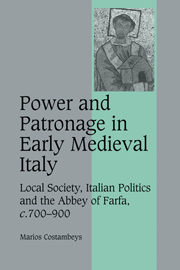 Power and Patronage in Early Medieval Italy
Power and Patronage in Early Medieval Italy Book contents
- Frontmatter
- Contents
- List of illustrations
- Acknowledgements
- Note on charter editions
- List of abbreviations
- Maps
- 1 INTRODUCTION
- 2 PATRONAGE AND LOMBARD RULERS
- 3 AUTHORITY, RULERSHIP AND THE ABBEY
- 4 THE MONKS AND ABBOTS OF FARFA: IDENTITIES AND AFFILIATIONS
- 5 SABINE LANDS AND LANDOWNERS
- 6 ELITE FAMILIES IN THE SABINA
- 7 FARFA AND ITALIAN POLITICS IN THE LOMBARD ERA
- 8 FARFA, ITALIAN POLITICS AND THE CAROLINGIANS
- Bibliography
- Index
- Cambridge Studies in Medieval Life and ThoughtFourth Series
3 - AUTHORITY, RULERSHIP AND THE ABBEY
Published online by Cambridge University Press: 17 July 2009
- Frontmatter
- Contents
- List of illustrations
- Acknowledgements
- Note on charter editions
- List of abbreviations
- Maps
- 1 INTRODUCTION
- 2 PATRONAGE AND LOMBARD RULERS
- 3 AUTHORITY, RULERSHIP AND THE ABBEY
- 4 THE MONKS AND ABBOTS OF FARFA: IDENTITIES AND AFFILIATIONS
- 5 SABINE LANDS AND LANDOWNERS
- 6 ELITE FAMILIES IN THE SABINA
- 7 FARFA AND ITALIAN POLITICS IN THE LOMBARD ERA
- 8 FARFA, ITALIAN POLITICS AND THE CAROLINGIANS
- Bibliography
- Index
- Cambridge Studies in Medieval Life and ThoughtFourth Series
Summary
LOCAL OFFICIALS, DUCAL POWER AND ‘PUBLIC’ PROPERTY
Our charters record not only transfers of rights over land, but also the description or delineation of relationships between people. By listing a supporting cast of those who participated in transactions and disputes, they reveal the balances of power between principal actors and supporting cast. In the eighth-century Sabina, none was more principal than the duke of Spoleto. He has traditionally been seen as the possessor of plenipotentiary power in his duchy – though whether this has been seen to derive from the Lombard king or from indigenous appropriation by the first dukes has depended on the ultimately irresoluble problem of the initial Lombard settlement in Italy. Yet an examination of the charters reveals not simply that the duke's power was extremely limited in practice, but rather that individual dukes recognized the difficulty of turning rhetorical claims to authority into practical power. It was a difficulty that resided chiefly in the power relationship between the duke and those intended to be his functionaries on the ground; and it is a difficulty that emerges most clearly when the duke's own rights were contested in court. The evidence we are about to discuss shows the dukes treating such disputes as contests about ducal authority and the definition of ‘public’ land. It points to a connection between the vindication of property rights and political power that was absolutely central to the way power was distributed, and did not necessarily advantage those who held public authority.
- Type
- Chapter
- Information
- Power and Patronage in Early Medieval ItalyLocal Society, Italian Politics and the Abbey of Farfa, c.700–900, pp. 90 - 132Publisher: Cambridge University PressPrint publication year: 2007


